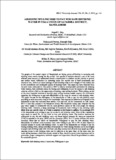Assessing willingness to pay for safe drinking water in Tala union of Satkhiradistrict, Bangladesh
Date
2016Publisher
© 2016 Published by BRAC UniversityAuthor
Dey, Nepal C.Parvez, Mahmood
Saba, Ratnajit
Khan, AS Moniruzzaman
Rahman, Md. Sajidur
Khanam, Roufa
Khan, Md. Reaz Uddin
Barna, Milan K.
Islam, Akramul
Metadata
Show full item recordCitation
Dey, N. C., Parvez, M., Saba, R., Khan, A. M., Rahman, M. S., Khanam, R., … Islam, A. (2016). Assessing willingness to pay for safe drinking water in Tala union of Satkhiradistrict, Bangladesh. BRAC University Journal, XI(2), 1–6.Abstract
The people of the coastal regioo of Bangladesh are facing severe difficulties in accessing safe
drinking water mainly during the dry period. Tala upazila of Satkhira district is ooe of the most
affected areas because of widespread arsenic contamination in shallow aquifer, salinity in ground
and surface water, difficulties in extractiog saline free aquifer due to hard rocks/stooes and
excessive iron. There is an acute shortage of safe drinking water in the villages of Tala mainly due
to low accessibility and inadequate quality of drinking water. This paper has been extracted from
the pilot study cooducted in Tala union in 2015 to identify local people's preference for drinking
water sources, their preferred option for buying and willingoess to pay for access to safe drinking
water as well as to find out the opportunity of existiog water selling business. Water pricing, as one
of the most iroportant element to develop water selling business model, requires the information
regarding the willingoess to pay and affordability of the users for access to safe drinking water.
This paper focuses on the willingoess of the households of Tala to pay for safe drinking water
according to socio-ecooomic class of the households. Data required to determine willingoess of the
households to pay was collected from survey, FGD and Kll. All the households in Tala Union,
8613 in total was covered in the household census. The household census dsta revealed that the
pipe water supply to households was the most preferred option by the local people for buying
drinking water. However, a large percentage of households were willing to buy drinking water
either from any specific place or if water is supplied to their house in gallons. On an average 60%
of the households were willing to pay for access to safe drinking water. Most of the respondents
were ready to spend Tk. 20 per week to buy safe drinking water. The positive respouse for
willingoess to pay for safe drinking water was fouod higher amongst the non-poor respondent
(71%) as opposed to the poor (58%) and the ultra-poor (48%). So it is pre!rY obvious that socioeconomic
status has an effect oo household's willingoess to pay for safe drinking water.
Households of different socio-economic class were willing to pay 3% to 6% of their respective
monthly income to access safe drinking water. As most of the households are willing to pay for
buying drinking water, entrepreneurship development for water selling business can be encouraged
to supply safe drinking water with minimum cost; thus eroployment of scme local people as well as
ensuring access to safe drinking water can be achieved at the same time. At the same time, the
water selling business, which has already started in Tala, should be given more importance and its
promotion, proper manageroent, technical support and supervision should be prioritized to ensure
its sustainable growth.

